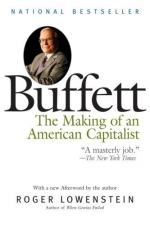
|
| Name: _________________________ | Period: ___________________ |
This test consists of 15 multiple choice questions and 5 short answer questions.
Multiple Choice Questions
1. Throughout his years in school, Buffett said he would live in:
(a) Ohaha.
(b) Washington.
(c) Los Angeles.
(d) New York.
2. Buffett told his partners all but the following:
(a) he could help place their money in municipal bonds.
(b) he would not act as their financial counsel.
(c) he would continue to manage their money.
(d) he recommended Sequoia Fund.
3. What did Buffett do that was different with Hochschild and Associated Cotton?
(a) purchased liquid sahres.
(b) traded one business for another.
(c) purchased small amounts.
(d) bought the entire businesses.
4. What did Buffett say he was putting his money into?
(a) money market funds.
(b) a new mutual fund.
(c) blue chip stocks.
(d) municipal bonds.
5. Studying under Graham allowed Warren to:
(a) quality to teach.
(b) develop his own natural abilities.
(c) learn to develop a business.
(d) complete his thesis.
6. How many partnerships was Warren running by the end of his first year?
(a) nine.
(b) five.
(c) four.
(d) three.
7. Which of the following was not one of the three companies that Buffett used to purchase stock and other companies?
(a) Diversified Retailing.
(b) American Express.
(c) Berkshire Hathaway.
(d) Blue Chip Stamps.
8. How did Buffett view investments and taxes?
(a) the object should be to achieve the largest after tax rate of compound.
(b) investments are made for tax purposes.
(c) tax avoidance is the reason for investing.
(d) the goal is to minimize taxes.
9. What industry did Buffett become interested in at this time?
(a) auto.
(b) high tech.
(c) newspaper.
(d) steel.
10. Buffett Partnership was Berkshire's biggest stockholder by:
(a) 1965.
(b) 1966.
(c) 1962.
(d) 1963.
11. What did Warren's father tell him when he returned from running away?
(a) he was sending him back to Nebraska.
(b) improve his grades or give up the paper route.
(c) quit his job as punishment.
(d) he was grounded for one month.
12. What company did the partnership buy that Warren became chairman of?
(a) Sanford Map.
(b) National American Fire Insurance.
(c) Control Data.
(d) Dempster.
13. In what simple way did Buffett find that people were still using their American Express cards?
(a) he hired an analyst to perform research
(b) he sat in a restaurant and watched how people paid thier bills.
(c) he contacted the chairman of the board.
(d) he hired a market research firm to perform a survey.
14. Warren attended graduate school at:
(a) Harvard.
(b) Princeton.
(c) Columbia.
(d) University of Chicago.
15. When did Buffett and Munger buy the Buffalo Evening News?
(a) 1978.
(b) 1980.
(c) 1976.
(d) 1974.
Short Answer Questions
1. Which of the following was not some thing that Howard Buffett was against?
2. What course did Warren teach at the University of Omaha?
3. Buffett began buying Berkshire-Hathaway stock in:
4. Warren worked on all of the following during this period:
5. Buffett began buying stocks:
|
This section contains 462 words (approx. 2 pages at 300 words per page) |

|




